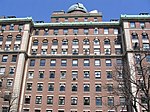Corpus Christi Church (New York City)
1906 establishments in New York City20th-century Roman Catholic church buildings in the United StatesBaroque Revival architecture in New York CityChristian organizations established in 1906Morningside Heights, Manhattan ... and 2 more
Roman Catholic churches completed in 1930Roman Catholic churches in Manhattan
The Church of Corpus Christi is a Roman Catholic parish church in the Roman Catholic Archdiocese of New York, located on West 121st Street between Broadway and Amsterdam Avenue in the Morningside Heights section of Manhattan, New York City. The parish was established in 1906. The parish priest is concurrently the Catholic chaplain at the nearby Columbia University.
Excerpt from the Wikipedia article Corpus Christi Church (New York City) (License: CC BY-SA 3.0, Authors).Corpus Christi Church (New York City)
West 121st Street, New York Manhattan
Geographical coordinates (GPS) Address Nearby Places Show on map
Geographical coordinates (GPS)
| Latitude | Longitude |
|---|---|
| N 40.811113888889 ° | E -73.960772222222 ° |
Address
West 121st Street 535
10027 New York, Manhattan
New York, United States
Open on Google Maps





